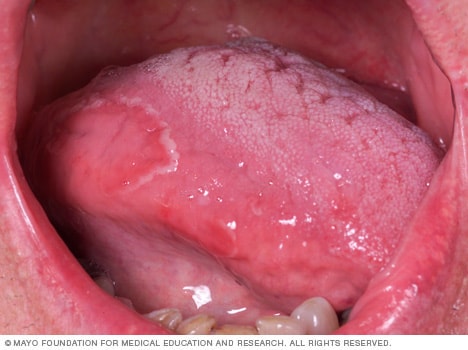Overview
Geographic tongue

Geographic tongue
Geographic tongue results from the loss of tiny hairlike projections (papillae) on your tongue's surface. This papillae loss appears as smooth, red patches of varying shapes and sizes.
Geographic tongue is an inflammatory but harmless condition affecting the surface of your tongue. The tongue is normally covered with tiny, pinkish-white bumps (papillae), which are actually short, fine, hairlike projections. With geographic tongue, patches on the surface of the tongue are missing papillae and appear as smooth, red "islands," often with slightly raised borders.
These patches (lesions) give the tongue a maplike, or geographic, appearance. The lesions often heal in one area and then move (migrate) to a different part of your tongue. Geographic tongue is also known as benign migratory glossitis.
Although geographic tongue may look alarming, it doesn't cause health problems and isn't associated with infection or cancer. Geographic tongue can sometimes cause tongue discomfort and increased sensitivity to certain substances, such as spices, salt and even sweets.
Products & Services
Symptoms
Signs and symptoms of geographic tongue may include:
- Smooth, red, irregularly shaped patches (lesions) on the top or side of your tongue
- Frequent changes in the location, size and shape of lesions
- Discomfort, pain or burning sensation in some cases, most often related to eating spicy or acidic foods
Many people with geographic tongue have no symptoms.
Geographic tongue can continue for days, months or years. The problem often resolves on its own but may appear again at a later time.
When to see a doctor
Geographic tongue is a minor — although sometimes uncomfortable — condition. However, lesions on the tongue may indicate other more-serious conditions of the tongue or diseases affecting the body in general. If you have lesions on the tongue that don't resolve within 10 days, see your doctor or dentist.
Causes
The cause of geographic tongue is unknown, and there's no way to prevent the condition. There may be a link between geographic tongue and psoriasis and between geographic tongue and lichen planus. But more research is needed to better understand possible connections.
Risk factors
Studies of factors that may be associated with an increased risk of geographic tongue have produced mixed results. Factors that are likely associated with an increased risk include:
- Family history. Some people with geographic tongue have a family history of the disorder, so inherited genetic factors may increase risk.
- Fissured tongue. People with geographic tongue often have another disorder called fissured tongue, which has the appearance of deep grooves (fissures) on the surface of the tongue.
Complications
Geographic tongue is a benign condition. It doesn't pose a threat to your health, cause long-term complications or increase your risk of major health problems.
However, anxiety about the condition is fairly common because:
- The appearance of the tongue may be embarrassing, depending on how visible the lesions are
- It may be difficult to be reassured that there is, in fact, nothing seriously wrong